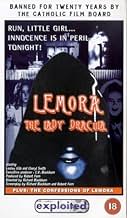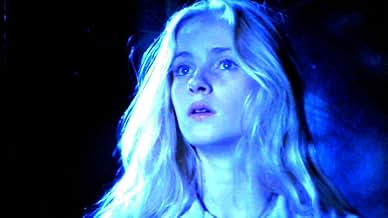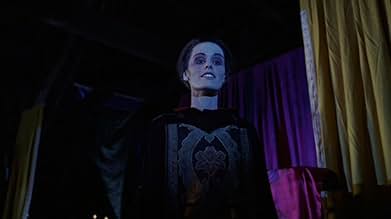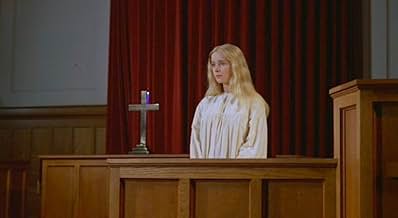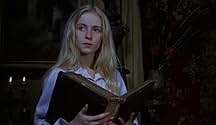CALIFICACIÓN DE IMDb
6.1/10
2.7 k
TU CALIFICACIÓN
Agrega una trama en tu idiomaA young girl who returns to her hometown to see her dying father finds herself being drawn into a web of vampirism and witchcraft.A young girl who returns to her hometown to see her dying father finds herself being drawn into a web of vampirism and witchcraft.A young girl who returns to her hometown to see her dying father finds herself being drawn into a web of vampirism and witchcraft.
- Dirección
- Guionistas
- Elenco
- Dirección
- Guionistas
- Todo el elenco y el equipo
- Producción, taquilla y más en IMDbPro
Opiniones destacadas
Never had heard of this one before, and I assumed it would just be a low-budget snoozer - but it's not! It's pretty damn good! Angelic girl leaves her church to find her murderous dad so she can forgive him and finds herself involved with vampires instead. Very well shot and quite creepy. This deserves more attention. Plenty of tension; it feels like there's something supernatural and terrifying around every corner. Cheryl Smith made her debut here - she would later adopt the professional nickname Rainbeaux and briefly play with the Runaways band.
Looking at the packaging to this lost classic, I was expecting a real crummy slice of early 70's schlock, hence why I took so long to actually put the tape into the VCR, so it was a total surprise when it turned out to be a genuinely very haunting, beautifully made creepfest.
The plot's fairly simple, for anyone who hasn't seen it, involving as it does a pure-as-the-driven snow church girl, Lila Lee, (of an unspecified age but I'm guessing around 13/14?) who receives a letter from the mysterious "Lemora" asking her to come out to some remote town in the middle of nowhere to see her long-lost gangster Father as he lies on his deathbed. Needless to say, Lemora is not all she appears to be and the mysteries surrounding her ominous precense unfold slowly but with a powerfully creepy vibe throughout the film's running time.
I was really taken aback by the care which appeared to go into making the film - the soundtrack, both musically and (more to the point) the sound effects themselves, were magnificently done with lots of 'night time' sounds quite high in the mix and some really appropriately done 'scare' noises, such as a scene in which Lila is attacked by a ghoul after taking a bath, which is punctuated by an intense high-pitched shrieking noise getting progressively higher in pitch as the scene goes on... it's maybe not the smartest trick in the book but it makes the scene a *LOT* more effective and it's little touches like this which made the movie. Same goes for the imagery, which is often very surreal and frightening. Much of the film is shot in the dark and usually if something comes out of the shadows, it's something horrible that you don't want to see! There are some beautifully done shots though, such as the one in which Lila discovers Lemora's vampirism by watching her through the window as she bites a young child - the way the shot is set up, I thought was very nicely done indeed... It may not be Mario Bava but then, if it was, it'd probably not be anywhere near as affecting - there's something about the subtlety of the film which gives it a low-key, moody edge.
There's very little gore, no real nudity and nothing that smacks of the exploitation clichés the packaging suggests. The much-touted 'lesbianism' angle on the back of the box is played as merely a quiet subtext, adding yet another pleasingly understated edge to the movie.
I dunno *just* how obscure this movie is, but it definitely doesn't deserve to be. I was very very impressed - it's a dark fairytale in the same vein as some of Jean Rollin's stuff but with a much more coherent narrative, none of the more explicit 'erotic' elements and a strange innocence to it which makes it all the creepier... Most of the film is seen through a child's eyes and many of the scares play on childhood fears, or at least things that would've creeped *me* out tremendously as a child and still lurk around at the back of 'ye olde braine'... There's little moments, like when Lila wakes up in 'the stone room' and looks through the bars to see laughing, dancing shadows behind the curtains in the mansion window nearby... urrgh, difficult to even explain why, but things like this *REALLY* give me the shivers. That probably sounds crass and silly the way I've written it, but trust me on this one, "Lemora" is one seriously unnerving little gem of a film and a must for anyone into horror cinema IMHO.
The plot's fairly simple, for anyone who hasn't seen it, involving as it does a pure-as-the-driven snow church girl, Lila Lee, (of an unspecified age but I'm guessing around 13/14?) who receives a letter from the mysterious "Lemora" asking her to come out to some remote town in the middle of nowhere to see her long-lost gangster Father as he lies on his deathbed. Needless to say, Lemora is not all she appears to be and the mysteries surrounding her ominous precense unfold slowly but with a powerfully creepy vibe throughout the film's running time.
I was really taken aback by the care which appeared to go into making the film - the soundtrack, both musically and (more to the point) the sound effects themselves, were magnificently done with lots of 'night time' sounds quite high in the mix and some really appropriately done 'scare' noises, such as a scene in which Lila is attacked by a ghoul after taking a bath, which is punctuated by an intense high-pitched shrieking noise getting progressively higher in pitch as the scene goes on... it's maybe not the smartest trick in the book but it makes the scene a *LOT* more effective and it's little touches like this which made the movie. Same goes for the imagery, which is often very surreal and frightening. Much of the film is shot in the dark and usually if something comes out of the shadows, it's something horrible that you don't want to see! There are some beautifully done shots though, such as the one in which Lila discovers Lemora's vampirism by watching her through the window as she bites a young child - the way the shot is set up, I thought was very nicely done indeed... It may not be Mario Bava but then, if it was, it'd probably not be anywhere near as affecting - there's something about the subtlety of the film which gives it a low-key, moody edge.
There's very little gore, no real nudity and nothing that smacks of the exploitation clichés the packaging suggests. The much-touted 'lesbianism' angle on the back of the box is played as merely a quiet subtext, adding yet another pleasingly understated edge to the movie.
I dunno *just* how obscure this movie is, but it definitely doesn't deserve to be. I was very very impressed - it's a dark fairytale in the same vein as some of Jean Rollin's stuff but with a much more coherent narrative, none of the more explicit 'erotic' elements and a strange innocence to it which makes it all the creepier... Most of the film is seen through a child's eyes and many of the scares play on childhood fears, or at least things that would've creeped *me* out tremendously as a child and still lurk around at the back of 'ye olde braine'... There's little moments, like when Lila wakes up in 'the stone room' and looks through the bars to see laughing, dancing shadows behind the curtains in the mansion window nearby... urrgh, difficult to even explain why, but things like this *REALLY* give me the shivers. That probably sounds crass and silly the way I've written it, but trust me on this one, "Lemora" is one seriously unnerving little gem of a film and a must for anyone into horror cinema IMHO.
Modern audiences may be a little put off by this movie at first glance - just on account of its fairly low production values - but it's definitely superior to most films of its kind, although it's such a unique oddity it's hard to compare it with anything else. Lemora plays more like a dark fairy tale than a horror movie and I actually found it to be thoughtful and moving when I watched it through to the end. Atmosphere, a great story, and a likable and sympathetic protagonist are what make this movie work.
Lemora has got a southern Gothic setting, and it takes place in the 1930's, which gives the film something of the feel of the weird fiction pulp magazines that were prevalent during that time. However, in contrast to most of those tales, the main character in Lemora is a thirteen-year old girl, which gives the movie a sexual/lost innocence subtext in addition to the 'ancient horror' themes that are typical of that tradition.
Lila Lee is an angelic-looking church singer, who we learn is also the daughter of a murdering gangster. Upon receiving a letter from her estranged father (who is now apparently very ill), she sets out on a journey to reunite with him. Every male character she encounters comes across as a leering predator, with the exception of her guardian, the Reverend, who is a good man struggling with his desires to possess the young girl.
Once she leaves for Asteroth, there is no turning back for Lila, as it becomes more and more clear that no matter what should befall her on her journey, she will never be the same singing angel that she once was. And her future looks pretty grim. Stranded in a horrific swampland, she is pursued by its gruesome inhabitants - men who have degenerated into a pack of diseased and squealing brutes - into the domain of a mysterious vampire and her group of immortal warlocks. Cheryl Smith was perfect for this as Lila - her looks and expression throughout conveying Lila's fear and confusion and innocent faith and her longing for someone she can trust; if you can't believe in her, or Leslie Glib as the dark title character, the movie fails, but they pull it off wonderfully. I found the score and songs that were used in Lemora to be strangely moving and the sound effects were often genuinely creepy.
From what I've read, this movie got into some trouble with the church upon it's release and I think it was placed on a list of banned films or something. But, I think that the theme of Lemora would have to be badly misconstrued for it to be seen as offensive in the way that its detractors would probably suggest. There is really nothing polemical or anti-Christian about it that I could see; and the movie treats its devout characters with affection and understanding as they struggle with themselves and the darkness that surrounds them. The ending, while not upbeat, is consistent and honest and makes you feel something. And leaves you thinking.
I own the great-looking DVD of Lemora, and the Synapse company did a terrific job with this movie. It was released in late 2004, with a dedication to the memory of Cheryl Smith, who passed away in 2002. I remember seeing her name (appearing as Cheryl Rainbeaux Smith) in association with a lot of drive-in type horror movies and teen sex comedies, but for years she was just a semi-familiar name to me. But within the last couple years I happened to see Caged Heat and Laserblast again, and came away thinking that there was something unique about this actress. Her presence was always natural and uncontrived, with a sad vulnerability in her eyes and a dreaminess about her that seemed to come from some place beyond this earth.
I was a young child in the 70s when these movies, like Lemora, were released. The adult content of many of the drive-in films of that era obviously kept me from seeing them when they first came out, but I enjoy going back and watching them now, and I've always found the feel and style of that pre-blockbuster period to be oddly creative and interesting. But it also may be that I feel a lot of nostalgia for those naive and carefree times in my own life, when I would have had a small boy's crush on a blonde-haired starlet like Cheryl Smith. I'm not sure I remember seeing any of Cheryl's movies when I was young, but in some way I associate her with a lot of the joy and fascination of those times. I imagine that many other people do too.
Lemora has got a southern Gothic setting, and it takes place in the 1930's, which gives the film something of the feel of the weird fiction pulp magazines that were prevalent during that time. However, in contrast to most of those tales, the main character in Lemora is a thirteen-year old girl, which gives the movie a sexual/lost innocence subtext in addition to the 'ancient horror' themes that are typical of that tradition.
Lila Lee is an angelic-looking church singer, who we learn is also the daughter of a murdering gangster. Upon receiving a letter from her estranged father (who is now apparently very ill), she sets out on a journey to reunite with him. Every male character she encounters comes across as a leering predator, with the exception of her guardian, the Reverend, who is a good man struggling with his desires to possess the young girl.
Once she leaves for Asteroth, there is no turning back for Lila, as it becomes more and more clear that no matter what should befall her on her journey, she will never be the same singing angel that she once was. And her future looks pretty grim. Stranded in a horrific swampland, she is pursued by its gruesome inhabitants - men who have degenerated into a pack of diseased and squealing brutes - into the domain of a mysterious vampire and her group of immortal warlocks. Cheryl Smith was perfect for this as Lila - her looks and expression throughout conveying Lila's fear and confusion and innocent faith and her longing for someone she can trust; if you can't believe in her, or Leslie Glib as the dark title character, the movie fails, but they pull it off wonderfully. I found the score and songs that were used in Lemora to be strangely moving and the sound effects were often genuinely creepy.
From what I've read, this movie got into some trouble with the church upon it's release and I think it was placed on a list of banned films or something. But, I think that the theme of Lemora would have to be badly misconstrued for it to be seen as offensive in the way that its detractors would probably suggest. There is really nothing polemical or anti-Christian about it that I could see; and the movie treats its devout characters with affection and understanding as they struggle with themselves and the darkness that surrounds them. The ending, while not upbeat, is consistent and honest and makes you feel something. And leaves you thinking.
I own the great-looking DVD of Lemora, and the Synapse company did a terrific job with this movie. It was released in late 2004, with a dedication to the memory of Cheryl Smith, who passed away in 2002. I remember seeing her name (appearing as Cheryl Rainbeaux Smith) in association with a lot of drive-in type horror movies and teen sex comedies, but for years she was just a semi-familiar name to me. But within the last couple years I happened to see Caged Heat and Laserblast again, and came away thinking that there was something unique about this actress. Her presence was always natural and uncontrived, with a sad vulnerability in her eyes and a dreaminess about her that seemed to come from some place beyond this earth.
I was a young child in the 70s when these movies, like Lemora, were released. The adult content of many of the drive-in films of that era obviously kept me from seeing them when they first came out, but I enjoy going back and watching them now, and I've always found the feel and style of that pre-blockbuster period to be oddly creative and interesting. But it also may be that I feel a lot of nostalgia for those naive and carefree times in my own life, when I would have had a small boy's crush on a blonde-haired starlet like Cheryl Smith. I'm not sure I remember seeing any of Cheryl's movies when I was young, but in some way I associate her with a lot of the joy and fascination of those times. I imagine that many other people do too.
It isn't hard to see why 'Lemora' was condemned by the Catholic film society. It's the story of a pubescent girl's fall from innocence and her sexual awakening, told in a 'fairytale for adults' manner. There are some amoral scenes to sit through with hints of lesbianism between the child and her vampire tutor that occasionally come across as sleazy, especially when the pubescent girl is given a bath by Lemora ('What an exciting figure you have').
Ambitiously set in the 1920s, a gangster brutally murders his wife and her lover before disappearing into the country. His thirteen-year-old daughter, Lila Lee (played by Cheryl Smith*) is cared for by the Reverend Mueller (director, Blackburn), who secretly houses sensuous feeling for his little choirgirl. Lila is delighted when she receives a letter from the mysterious Lemora, detailing her father's deteriorating condition. Lemora demands that Lila be present at her father's bed immediately. Lila's journey to Lemora's hidden cottage, through dense dark woods is constantly plagued; firstly, by lecherous older men, then a psychopathic bus-driver and then a group of fanged beasts who chase her from the bus. The seductive Lemora's house is filled with children, all of whom are part of her growing legion of vampires. The Reverend has decided to admit his sordid desires to Lila and begins to search for her. You'd think that was enough plot development, but after this point more twists follow, which might confuse some viewers.
'Lemora', a late night TV favourite, is considered to be one of the classic vampire films of the early seventies, opposite 'Count Yorga, Vampire' (Bob Kelljan, 1970). There strong sexual overtones and the corruption of innocence storyline were the prime reasons why the Catholic Film Board wanted this film banned for almost twenty years. Due to its lack of budget, (poor sound and sketchy cinematography) and European feel, the film often looks like a porn film which doesn't help matters concerning the sexual connotations, but they're never really presented in a exploitative manner.
Ambitiously set in the 1920s, a gangster brutally murders his wife and her lover before disappearing into the country. His thirteen-year-old daughter, Lila Lee (played by Cheryl Smith*) is cared for by the Reverend Mueller (director, Blackburn), who secretly houses sensuous feeling for his little choirgirl. Lila is delighted when she receives a letter from the mysterious Lemora, detailing her father's deteriorating condition. Lemora demands that Lila be present at her father's bed immediately. Lila's journey to Lemora's hidden cottage, through dense dark woods is constantly plagued; firstly, by lecherous older men, then a psychopathic bus-driver and then a group of fanged beasts who chase her from the bus. The seductive Lemora's house is filled with children, all of whom are part of her growing legion of vampires. The Reverend has decided to admit his sordid desires to Lila and begins to search for her. You'd think that was enough plot development, but after this point more twists follow, which might confuse some viewers.
'Lemora', a late night TV favourite, is considered to be one of the classic vampire films of the early seventies, opposite 'Count Yorga, Vampire' (Bob Kelljan, 1970). There strong sexual overtones and the corruption of innocence storyline were the prime reasons why the Catholic Film Board wanted this film banned for almost twenty years. Due to its lack of budget, (poor sound and sketchy cinematography) and European feel, the film often looks like a porn film which doesn't help matters concerning the sexual connotations, but they're never really presented in a exploitative manner.
The late and sorely missed Cheryl Smith stars as Lila, the lovely pubescent daughter of a notorious gangster, who is being fostered by a kind-hearted minister. Unaware of her father's whereabouts and concerned for his well-being, she receives a letter indicating that he lays ailing in a mapped location, and should she choose to visit him, then she must do so alone. Thus begins Lila's dark odyssey...from the minute she steps away from the familiar safety of her front door, her nest of childhood innocence is given way to a bleak and frightening world fraught with drunks, strumpets, and lecherous men...but a corporeity of a far more uncanny and sinister nature awaits her at her journey's end...the mysterious letter she received was a siren-song luring her to the incommunicado home of Lemora, a vampiress with an appetence for the blood of youths. This ancient, statuesque creature resides with her cackling old charlady and a mottle of emaciated children in a dark swampland where savage ghouls prowl the night.
The bizarre nexus ensuingly forged between Lemora and Lila is simultaneously horrific and erotically charged...the small-framed, willowy Lila futilely resisting, though apprehensively drawn to, the imposing and mysterious Lemora. It's an arousing 'butch/femme' dynamic which works well, and is illustrated more intricately than most examples of the gratis lesbiana inclusive to vampire cinema.
An artfully executed celestial nightmare with subtexts touching on religious hypocrisy and elegiac loss of innocence, LEMORA demonstrates perfectly how integrity, creativity, and resourcefulness can compensate heartily for dearth of funds in a motion picture production.
Superior. 9/10.
The bizarre nexus ensuingly forged between Lemora and Lila is simultaneously horrific and erotically charged...the small-framed, willowy Lila futilely resisting, though apprehensively drawn to, the imposing and mysterious Lemora. It's an arousing 'butch/femme' dynamic which works well, and is illustrated more intricately than most examples of the gratis lesbiana inclusive to vampire cinema.
An artfully executed celestial nightmare with subtexts touching on religious hypocrisy and elegiac loss of innocence, LEMORA demonstrates perfectly how integrity, creativity, and resourcefulness can compensate heartily for dearth of funds in a motion picture production.
Superior. 9/10.
¿Sabías que…?
- TriviaNotably similar to the story Carmilla by Sheridan Le Fanu in which a female seduces a teenage girl. Towards the end of the film Lemora indicates that she has had many names.
- ErroresWhen Lila is first taken into the house by Lemora, she is told to go upstairs to her room. Lemora says "It is the first open door at the end of the hall." But when Lila goes upstairs ALL of the doors are closed.
- ConexionesFeatured in Movie Macabre: Lemora A Child's Tale of the Supernatural (1983)
- Bandas sonorasPaper Angel
Sung by The Black Whole
Selecciones populares
Inicia sesión para calificar y agrega a la lista de videos para obtener recomendaciones personalizadas
- How long is Lemora: A Child's Tale of the Supernatural?Con tecnología de Alexa
Detalles
- Fecha de lanzamiento
- País de origen
- Idioma
- También se conoce como
- Lemora: A Child's Tale of the Supernatural
- Locaciones de filmación
- Phillips Mansion - 2640 W. Pomona Boulevard, Pomona, California, Estados Unidos(Lemora's house exteriors)
- Productora
- Ver más créditos de la compañía en IMDbPro
Contribuir a esta página
Sugiere una edición o agrega el contenido que falta

Principales brechas de datos
By what name was Lemora: poseída del diablo (1973) officially released in India in English?
Responda

